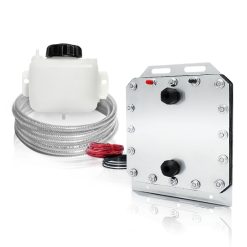No products in the cart.
Results of NASA’ s experiments with hydrogen in internal combustion engines
Direct from 1977 article by *NASA:
http://ntrs.nasa.gov/archive/nasa/casi.ntrs.nasa.gov/19770016170.pdf
“Lean-mixture-ratio combustion in internal-combustion engines has the potential of producing low emissions and higher thermal efficiency for several reasons.
First, excess oxygen in the charge further oxidizes unburned hydrocarbons and carbon monoxide.
Second, excess oxygen lowers the peak combustion temperatures, which inhibits the formation of oxides of nitrogen.
Third, the lower combustion temperatures increase the mixture specific heat ratio by decreasing the net dissociation losses.
Fourth, as the specific heat ratio increases, the cycle thermal efficiency also increases, which gives the potential for better fuel economy.”
To summarize:
The more efficient HHO engine has more fuel energy converted into useful mechanical energy and less into wasted thermal energy.
This is apparent to the user in increased fuel economy, lower combustion temperatures and approximately 100C lower exhaust temperature.
The HHO assisted combustion ignites faster and more completely. The same amount of fuel explodes more thoroughly creating more power. This power is transferred into mechanical energy and not heat.
Further, the generated force acts when it is supposed to – at the beginning of the combustion stroke of the engine. Not later when the piston is already half way down the stroke or even worse, while returning on the exhaust stroke.
Residual combustion on the exhaust stroke impeded engine rotation (lowering economy) and increases exhaust temperature and shortens the life of the exhaust valves.
*NASA – National Aeronautics and Space Administration
Read more:
How hydrogen generators for vehicles work
How to select correct equipment
Setup and operation of HHO equipment, safety, compatibility
Engine carbon cleaning services vs hydrogen on demand generators
Effect of Hydrogen HHO on Emissions
How to convert engines to use hydrogen as primary fuel
What happens when too much hydrogen is supplied to an engine
Visit our store
Summary

Article Name
Results of NASA’ s experiments with hydrogen in internal combustion engines
Description
The more efficient HHO engine has more fuel energy converted into useful mechanical energy and less into wasted thermal energy. This is apparent to the user in increased fuel economy, lower combustion temperatures and approximately 100C lower exhaust temperature.
Author
Better Fuel Technology
Publisher Name
Better Fuel Technology
Publisher Logo









